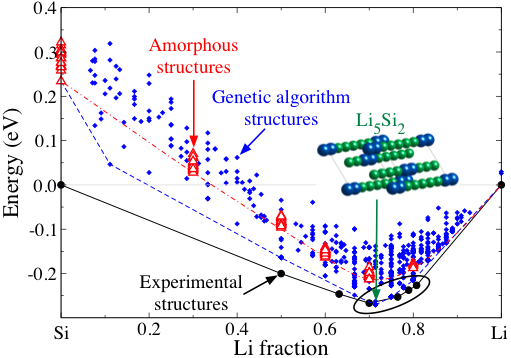GASP
 The Genetic algorithm for structure prediction – GASP – predicts the structure and composition of stable and metastable phases of crystals, molecules, atomic clusters and defects from first-principles. The GASP program is interfaced to many energy codes including: VASP, LAMMPS, MOPAC, Gulp, JDFTx and can efficiently run on parallel architecturesarchitectures. Lead developers: William W. Tipton, Ben Revard, Stewart Wenner, Anna Yesypenko, and Richard G. Hennig
The Genetic algorithm for structure prediction – GASP – predicts the structure and composition of stable and metastable phases of crystals, molecules, atomic clusters and defects from first-principles. The GASP program is interfaced to many energy codes including: VASP, LAMMPS, MOPAC, Gulp, JDFTx and can efficiently run on parallel architecturesarchitectures. Lead developers: William W. Tipton, Ben Revard, Stewart Wenner, Anna Yesypenko, and Richard G. Hennig
Download
The GASP code is freely available under the GPL v3 license. Look here for the binary version of the code described in the QuickStart guide. To view the source, please see our github repo. The gasp manual pdf is located here.
If you use the method in your research, please cite the following two papers in your publications:
- A grand canonical genetic algorithm for the prediction of multi-component phase diagrams and testing of empirical potentials, W. W. Tipton, and R. G. Hennig, J. Phys.: Cond. Matter 25, 495401 (2013). [doi:10.1088/0953-8984/25/49/495401]
- Structure and Stability Prediction of Compounds with Evolutionary Algorithms, B. C. Revard, W. W. Tipton, and R. G. Hennig, Topics in Current Chemistry 345, 181 (2014). [doi:10.1007/128_2013_489]
Publications
- Structure and Stability Prediction of Compounds with Evolutionary Algorithms.
B. C. Revard, W. W. Tipton, and R. G. Hennig. Topics in Current Chemistry 345, 181 (2014).
doi:10.1007/128_2013_489 - Prediction of Structures, Phase Stability and Electrical Potential of Li-Si Battery Anode Materials.
W. W. Tipton, C. R. Bealing, K. Mathew, R. G. Hennig. Phys. Rev. B 87, 184114 (2013).
doi:10.1103/PhysRevB.87.184114 - Ab initio based empirical potential used to study the mechanical properties of molybdenum.
H. Park, M. R. Fellinger, T. J. Lenosky, W. W. Tipton, D. R. Trinkle, S. P. Rudin, C. Woodward, J. W. Wilkins, and R. G. Hennig. Phys. Rev. B 85, 214121 (2012).
doi:10.1103/PhysRevB.85.214121. - Pressure-induced structure transitions in Eu metal to 92 GPa.
W. Bi, Y. Meng, R. S. Kumar, A. L. Cornelius, W. W. Tipton, R. G. Hennig, Y. Zhang, C. Chen, and J. S. Schilling. Phys. Rev. B 83, 104106 (2011),
doi:10.1103/PhysRevB.83.104106 - Emergent reduction of electronic state dimensionality in dense ordered Li-Be alloys.
J. Feng, R. G. Hennig, N. W. Ashcroft and Roald Hoffmann. Nature 451, 445 (2008),
doi:10.1038/nature06442
VASPsol

We implemented an implicit solvation model that describes the effect of electrostatics, cavitation, and dispersion on the interaction between a solute and solvent into the plane-wave DFT code VASP. Our implementation provides a computationally efficient means to calculate the effects of solvation on molecules and crystal surfaces. The strength of our solvation model implementation is its capability to handle large periodic systems such as metal and semiconductor surfaces and its interoperability with standard ultrasoft pseudopotential and projector-augmented wave potential libraries. The software is freely available as a patch to the original VASP code from our website: http://vaspsol.mse.ufl.edu.
Lead developers: Kiran Mathew and Richard Hennig
Publications
- Implicit solvation model for density-functional study of nanocrystal surfaces and reaction pathways.
K. Mathew, R. Sundararaman, K. Letchworth-Weaver, T. A. Arias, and R. G. Hennig. J. Chem. Phys. 140, 084106 (2014).
doi:10.1063/1.4865107 - Accuracy of Exchange-Correlation Functionals and Effect of Solvation on the Surface Energy of Copper.
M. Fishman, H. L. Zhuang, K. Mathew, W. Dirschka, and R. G. Hennig. Phys. Rev. B 87, 245402 (2013).
doi:10.1103/PhysRevB.87.245402
QMCsol
To describe heterogeneous solid/liquid materials interfaces we developed and implemented a new implicit solvation method for quantum Monte Carlo that avoids thermodynamic sampling or explicit solvent electrons. The method is based on a rigorous statistical treatment of the solvent and utilizes a variational theorem. The method is applicable to a variety of challenges in materials science ranging from transition states of solvated molecules to surface reactions in liquid environments. The method is implemented into the quantum Monte Carlo code CASINO and interfaced to the JDFTx package for generating the trial orbitals and solvation potential.
Lead developer: Katie Schwarz
Publications
- A framework for solvation in quantum Monte Carlo.
K. A. Schwarz, R. Sundararaman, K. Letchworth-Weaver, T. A. Arias, and R. G. Hennig. Phys. Rev. B 85, 201102(R) (2012), Selected as Editor’s Suggestion.
doi:10.1103/PhysRevB.85.201102
GitHub
All our open source software development efforts have been moved to github.
Check us out on github at https://github.com/henniggroup